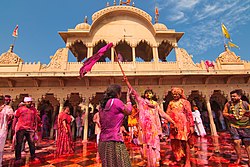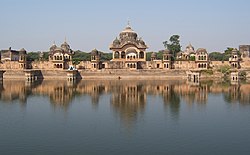Braj
Braj | |
|---|---|
top to bottom: Radha Krishna at Kirti Temple, Barsana,
Krishna Janmasthan in Mathura, Radha Rani Temple in Barsana, Prem Mandir in Vrindavan and Kusum Sarovar in Govardhan Hill. | |
| Country | |
| Region | Northern India |
| Proposed Districts | |
| Language | Braj Bhasha |
Braj, also known as Vraj, Vraja, Brij or Brijbhumi, is a region in India on both sides of the Yamuna river with its centre at Mathura-Vrindavan in Uttar Pradesh state encompassing the area which also includes Palwal and Ballabhgarh in Haryana state, Bharatpur, Karauli and Dholpur in Rajasthan state and Morena District in Madhya Pradesh.[1] Within Uttar Pradesh, it is very well demarcated culturally, the area stretches from the Mathura, Aligarh, Agra, Hathras and districts up to the Farrukhabad, Mainpuri and Etah districts.[2] Braj region is associated with Radha and Krishna who according to scriptures were born in Barsana and Mathura respectively.[3][4] It is the main centre of Krishna circuit of Hindu pilgrimage.[1]

It is located 150 km south of Delhi and 50 km northwest of Agra.[1]
Etymology
This section needs additional citations for verification. (October 2023) |
The term Braj is derived from the Sanskrit word vraja (व्रज).[4][5] Vraja was first mentioned in Rigveda, and in Sanskrit it means a pasture, shelter or resort for cattle from the Sanskrit term "vraj" which means "go" in English.The term "Braj" refers to a region in northern India, primarily in the state of Uttar Pradesh, that is associated with Krishna and his childhood pastimes. The etymology of the word "Braj" is derived from the Sanskrit term "Vraj," which means "pasture" or "cow grazing grounds."
The region of Braj holds great significance in Hindu mythology and religious traditions, as it is believed to be the place where Krishna spent his early years and performed various divine activities. The region is dotted with numerous towns and villages associated with Krishna, such as Mathura, Vrindavan, and Govardhan, which attract millions of pilgrims and devotees each year.
The term "Braj" has become synonymous with the spiritual and cultural heritage of Krishna. It represents the landscape, the people, the traditions, and the devotion associated with Krishna's life and teachings. The Bhakti (devotional) movement, which flourished in the medieval period, played a significant role in popularizing the importance of Braj and its association with Krishna.
In summary, the etymology of the term "Braj" is rooted in the Sanskrit word "Vraj," which signifies the pastoral or cow grazing grounds. Over time, it has become synonymous with the region associated with Lord Krishna and his childhood pastimes.
Braj pilgrimage circuits
Since this is a site associated with the Vedic era, Lord Krishna and Mahabharata, it is an important place of pilgrimage for Hindus. It is one of the three main pilgrimage sites related to Krishna circuit, namely 48 kos parikrama of Kurukshetra in Haryana state, Vraja Parikrama in Mathura in Uttar Pradesh and Dwarka Parikrama (Dwarkadish yatra) at Dwarkadhish Temple in Gujarat.
The Braj Yatra circuit of pilgrimage was formally established by the 16th-century sadhus of the vaishnava sampradaya with fixed routes, itinerary and rituals. The area the circuit covers is spread across 2500 km2 with 84 kos or 300 km long periphery extending 10 km to the east and 50 km to the north and west. Braj has two main types of pilgrimage circuits, the traditional longer Braj Yatra encompassing the whole circuit, and the other shorter significantly modified contemporary point-to-point pilgrimage to visit the main sites at Mathura, Vrindavan, Gokul, Govardhan. The former, longer traditional pilgrimage route, also includes additional sacred sites Nandgaon and Barsana with travel on foot.[1]
The demands for Braj Bhoomi, or the region of Braj associated with Lord Krishna, can vary among different groups and individuals. Here are some common demands or aspirations associated with Braj Bhoomi:
Preservation of religious and cultural heritage: Many people, especially devotees and religious organizations, demand the preservation and conservation of the religious and cultural heritage of Braj Bhoomi. This includes maintaining and restoring ancient temples, ghats (riverfront steps), and other sacred sites associated with Lord Krishna's pastimes.
Environmental conservation: Braj Bhoomi is known for its natural beauty, including rivers, forests, and wildlife. There are demands for preserving and protecting the ecological balance of the region, including efforts to clean and rejuvenate rivers such as the Yamuna, which holds immense religious significance for Krishna devotees.
Infrastructure development: As a popular pilgrimage site, there are demands for improved infrastructure in Braj Bhoomi. This includes better transportation facilities, road networks, accommodations, sanitation facilities, and crowd management systems to cater to the needs of the increasing number of visitors.
Tourism promotion: Braj Bhoomi attracts millions of tourists and pilgrims each year. There are demands for effective tourism promotion and marketing strategies to enhance the visitor experience, promote local businesses, and generate employment opportunities for the local population.
Educational institutions: Some people advocate for the establishment of educational institutions, including schools and universities, that focus on the teachings of Lord Krishna and promote the cultural heritage of Braj Bhoomi. This is seen as a way to impart knowledge and values associated with Krishna's life and teachings to future generations.
Heritage tourism development: Braj Bhoomi has immense potential for heritage tourism, and there are demands for initiatives to develop and promote heritage tourism circuits, guided tours, and cultural events that showcase the rich history and traditions of the region.
It's important to note that these demands can vary among different stakeholders, including religious organizations, environmental activists, local communities, and tourism bodies. The government and various organizations work together to address these demands while balancing the preservation of the cultural heritage and the sustainable development of the region.
See also
- Regional
- Braj language
- Vajji, the ancient region of the Vṛji janapada that Bajjika evolved from
- Religious
- Vedic era
- General
References
- ^ a b c d Janet Cochrane, 2008, Asian Tourism: Growth and Change, page 249.
- ^ Lucia Michelutti (2002). "Sons of Krishna: the politics of Yadav community formation in a North Indian town" (PDF). PhD Thesis Social Anthropology. London School of Economics and Political Science University of London. p. 49. Retrieved 20 May 2015.
- ^ Lynch, Owen M. (31 December 1990), "ONE. The Social Construction of Emotion in India", Divine Passions, University of California Press, pp. 3–34, doi:10.1525/9780520309753-002, ISBN 978-0-520-30975-3
- ^ a b Lucia Michelutti (2002). "Sons of Krishna: the politics of Yadav community formation in a North Indian town" (PDF). PhD Thesis Social Anthropology. London School of Economics and Political Science University of London. p. 46. Retrieved 20 May 2015.
- ^ Prasad, Dev (2015). Krishna: A Journey through the Lands & Legends of Krishna. Jaico Publishing House. ISBN 978-81-8495-170-7.
Further reading
- Rupert Snell, The Hindi Classical Tradition: A Braj Bhasa Reader. Includes grammar, readings and translations, and a good glossary.






